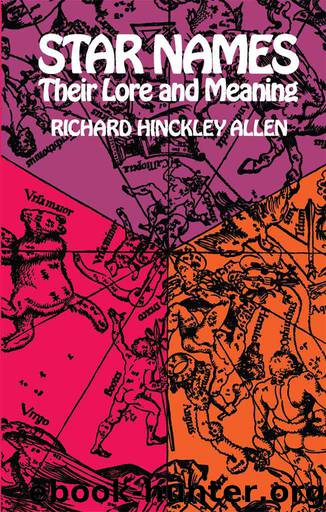Star Names: Their Lore and Meaning (Dover Books on Astronomy) by Allen Richard H

Author:Allen, Richard H. [Allen, Richard H.]
Language: eng
Format: epub
Publisher: Dover Publications
Published: 2013-02-28T00:00:00+00:00
The celestial equator now passes through the Belt, but was 12° below it 4000 years ago.
η, Triple,3.5, 5, and 5,
occasionally and very appropriately has been designated Saiph, from Saif al Jabbār, the Sword of the Giant; but this title included other adjacent stars in the same line of sight,— the Ensis of Cicero,— and all supposed to have been a separate constellation with Pliny.
Al Sufi called them Al Alā, which we have seen applied to the Belt; and Burritt, the Ell, because this line of stars “is once and a quarter the length of the yard.”
θ1,4.6,pale white,
although not individually named, marks the Fish-mouth of the Great Nebula, N. G. C. 1976, 42 M., in the sword scabbard of the figure, with the celebrated Trapezium in its midst. De Quincey gave a characteristic description of it in one of his Essays in Philosophy.
This nebula, faintly visible to the naked eye, was not even mentioned by Galileo, and is generally thought to have been accidentally discovered by Christian Huygens in 1656, and described in his Systerna Saiurnium half a century after Galileo’s adaptation of the principle of the telescope to astronomical use; but Cysatus of Lucerne had already known it in 1618. This was the first1 object to which Sir William Herschel directed, on the 4th of March, 1774, the first serviceable telescope of his own construction after two hundred failures; and the first nebula to be successfully photographed, as it was by Professor Henry Draper, at Hastings-upon-Hudson, on the 30th of September, 1880.
Its spectrum is purely gaseous, and spectroscopic investigations by Sir William and Lady Huggins seem to show “a unity of composition of the [trapezium] stars and nebulae which surround them and link them together.” Keeler finds from spectroscopic observations that it and our system are separating at the rate of ten miles a second. Holden thinks it of fluctuating brightness.
The nebula proper covers a space equal to the apparent size of the moon, but nebulosity extends over a very much larger area, for recent observations by Swift, by William H. Pickering in 1889 from Wilson’s Peak, and by Barnard with the camera on Mount Hamilton in October, 1894, reveal nebulous matter, 14° to 15° in diameter, that includes the Belt and much of the body of Orion. Barnard says of it: “Compared with this enormous nebula, the old 0, or so-called Great Nebula, is but a pigmy.” A million of globes, each equal in diameter to that of the earth’s orbit, would not equal this in extent. One of the Harvard photographs of 1889 showed a certain amount of spiral structure in the Great Nebula.
The adjacent nebula, N. G. C. 1982, catalogued separately by Messier as 43, is shown on a photograph of the 30th of November, 1886, by Roberts, to be connected with it by threads of nebulosity.
At least six stars are found in the Trapezium, the four largest being ot the 5 th, 6th, 7th, and 8th magnitudes, easily visible in a 2¼-inch glass with a power of 140.
Download
This site does not store any files on its server. We only index and link to content provided by other sites. Please contact the content providers to delete copyright contents if any and email us, we'll remove relevant links or contents immediately.
| Aeronautics & Astronautics | Astronomy |
| Astrophysics & Space Science | Comets, Meteors & Asteroids |
| Cosmology | Mars |
| Solar System | Star-Gazing |
| Telescopes | UFOs |
Tools of Titans by Timothy Ferriss(8216)
Turbulence by E. J. Noyes(7935)
Secrets of Antigravity Propulsion: Tesla, UFOs, and Classified Aerospace Technology by Ph.D. Paul A. Laviolette(5309)
Astrophysics for People in a Hurry by Neil DeGrasse Tyson(5130)
Room 212 by Kate Stewart(5035)
Design of Trajectory Optimization Approach for Space Maneuver Vehicle Skip Entry Problems by Runqi Chai & Al Savvaris & Antonios Tsourdos & Senchun Chai(5011)
Pale Blue Dot by Carl Sagan(4909)
The David Icke Guide to the Global Conspiracy (and how to end it) by David Icke(4624)
A Journey Through Divination and Astronomy by Publishing Pottermore(4344)
Goodbye Paradise(3726)
Apollo 8 by Jeffrey Kluger(3635)
COSMOS by Carl Sagan(3554)
Losing the Nobel Prize by Brian Keating(3498)
The Five People You Meet in Heaven by Mitch Albom(3474)
How to Read Water: Clues and Patterns from Puddles to the Sea (Natural Navigation) by Tristan Gooley(3406)
Brief Answers to the Big Questions by Stephen Hawking(3369)
How to Read Nature by Tristan Gooley(3249)
The Order of Time by Carlo Rovelli(3145)
A Brief History of Time by Stephen Hawking(2960)
